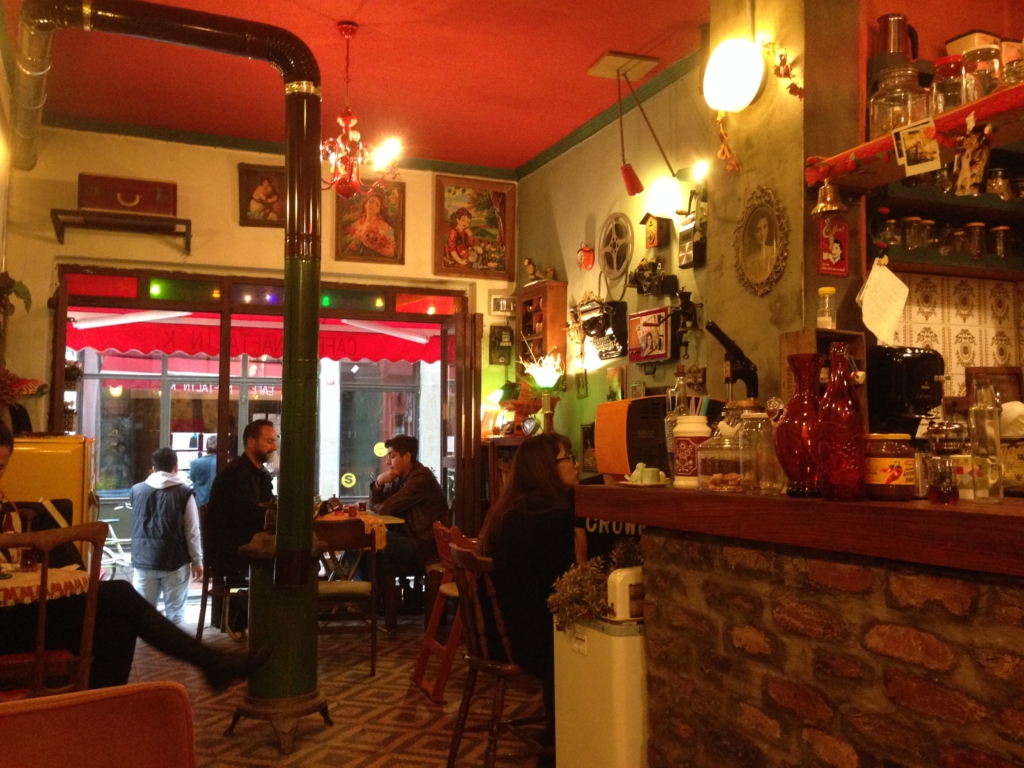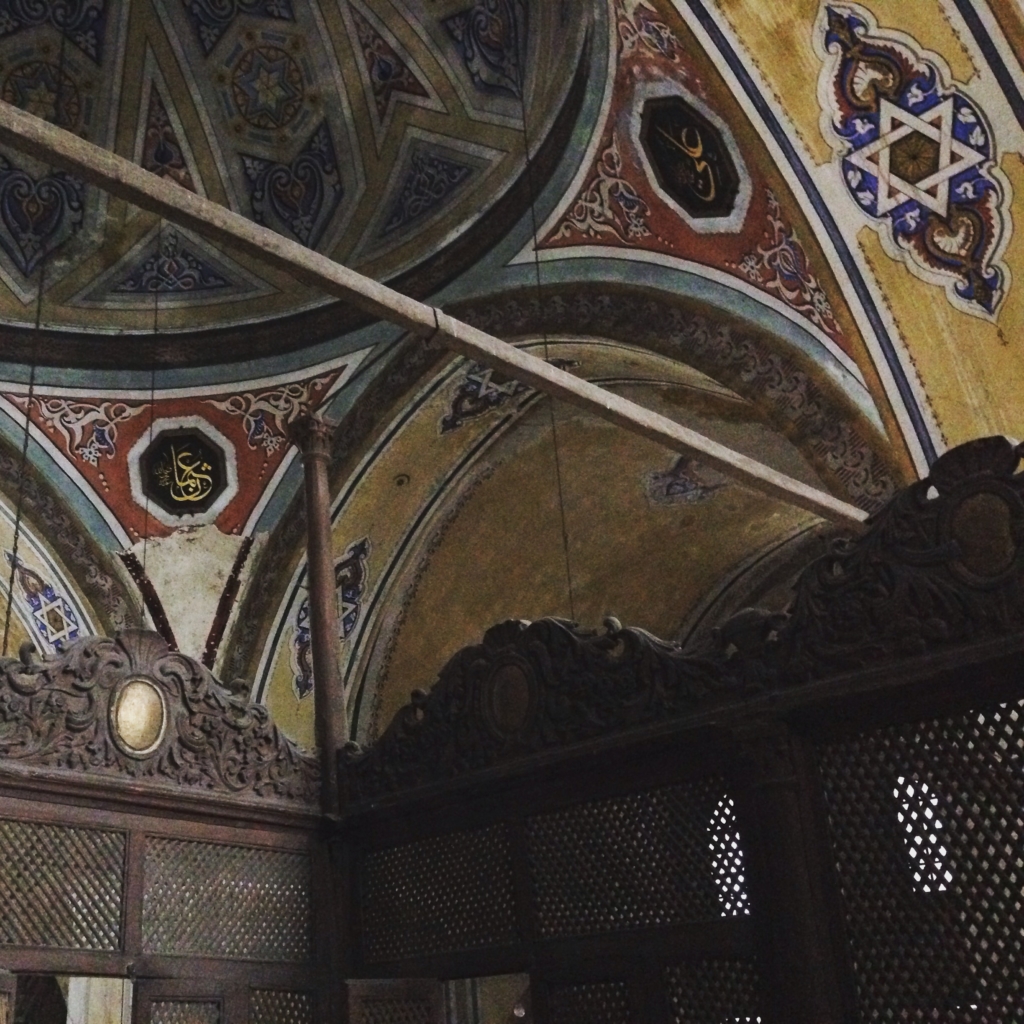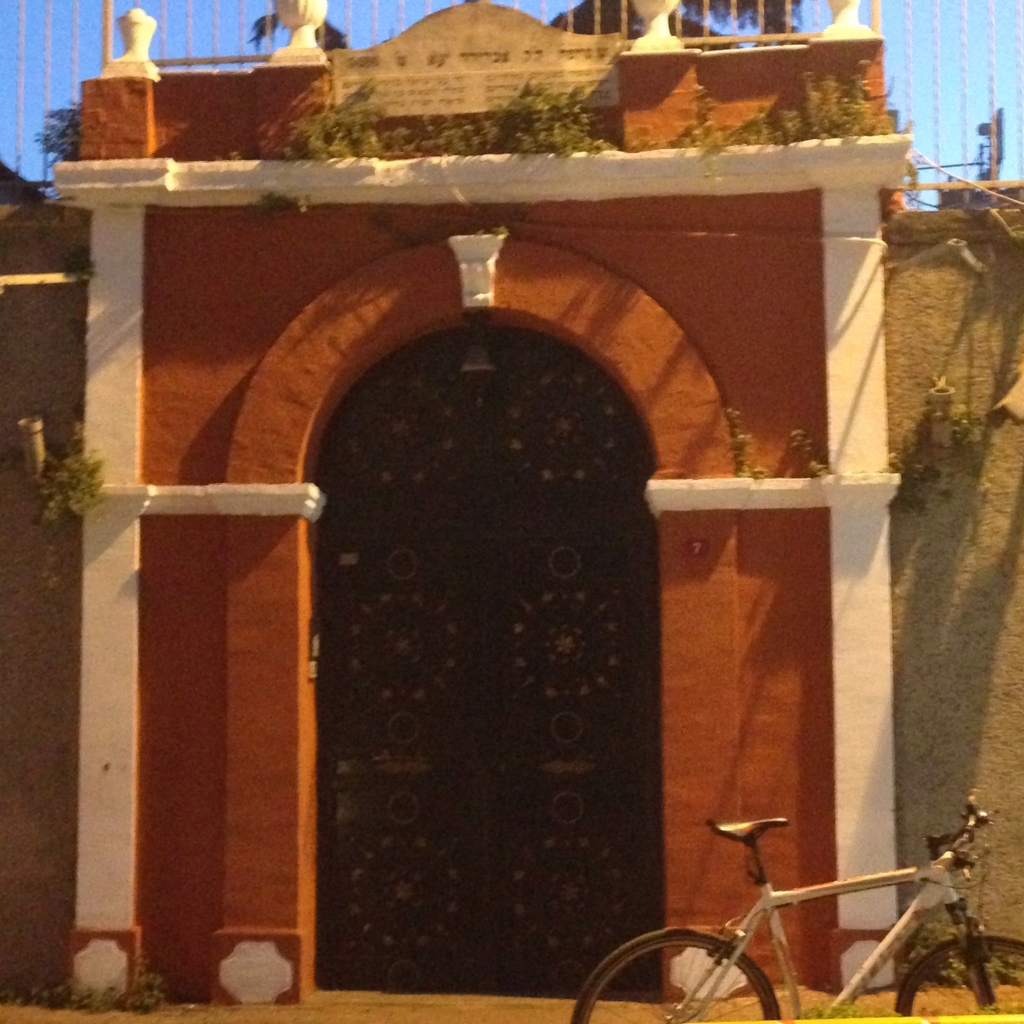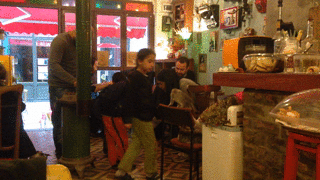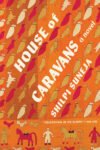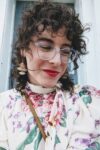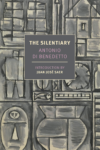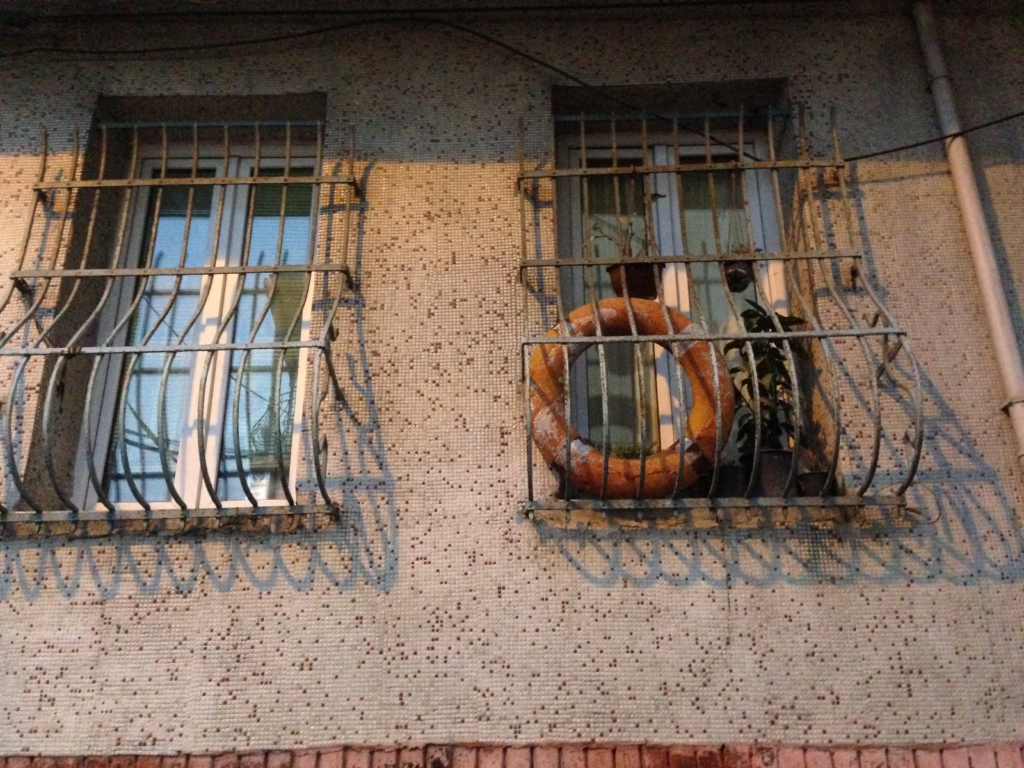 My friend and I come to Balat on the metro to see Wael Shawky’s Cabaret Crusades. We try to follow directions in the narrow, winding alleyways, looking for an old hammam where the video is supposed to be showing. We have joined the ranks of Istanbulites who cross over to the old town for our cultural edification: it’s one of the oldest neighborhoods in the city and has quickly become a cultural center to rival Istanbul’s older hipster hubs, Beyoglu and Karaköy.
My friend and I come to Balat on the metro to see Wael Shawky’s Cabaret Crusades. We try to follow directions in the narrow, winding alleyways, looking for an old hammam where the video is supposed to be showing. We have joined the ranks of Istanbulites who cross over to the old town for our cultural edification: it’s one of the oldest neighborhoods in the city and has quickly become a cultural center to rival Istanbul’s older hipster hubs, Beyoglu and Karaköy.
We get lost and wander into a Byzantine looking mosque, just in time for dhur prayers. We go in and walk up the dim stairs to the women’s section, picking our way through construction material and cables. When we finally reach the gallery, the set up is quite different from new mosques. It feels more homely: the carpeting is not the typical wall-to-wall red, with spaces marked for individual worshippers, but a jumble of old carpets — presumably gifts from the congregation — thrown together in a patchwork. In Turkey one often hears about the Ottoman Empire’s “multicultural fabric,” and in Balat, the metaphor is everywhere. When we look up we see that the plaster of the central dome and the quarter domes are coming off, along with the beautiful painted patterns. Stars of David are very prominent, and this makes us wonder whether the mosque was converted from a synagogue. We go out and find the plaque that says this is Gül Mosque, converted from a Byzantine church where the emperor had prayed for the deliverance of his city the night before the Turks broke through the walls.
It turns out we walked right past the hammam — from the outside, it looks like just another construction site. We go around the corner and find the entrance. At the far end, there is a screen showing the Wael Shawky video. On the floor there are old carpets, like in the mosque, a bit more tidily put together to provide a lounging area to sit and watch the video. By the time we have made ourselves comfortable, the scene on Shawky’s all-puppet crusade film has moved to Constantinople. In a perfect moment of mise-en-abime, we see the puppets under the Byzantine dome, first negotiating and then killing one another. A few minutes later Hagia Sophia is in flames, and Shawky’s small, grotesque crusader puppets are making their way towards Jerusalem.
As with all arts and culture events held in Balat, the space asks for as much attention as the art itself. As we leave the show we are reading the small leaflet that talks about the history of the hammam. We wander up towards the hill, then walk along the high wall that protects the patriarchate. On the other side of the road are crowded apartment blocks, clearly stuffed with Balatians and their possessions. Even the iron-grilled window alcoves seem to be used for storage; they’re stuffed with children’s toys and household appliances. On one of the blocks, near the entrance door I see a small notice, in Turkish, saying Voting is Un-Islamic.
We end the day at Café NaftalinK, a cozy spot filled with old chairs and bric-a-brac. We stuff ourselves with cake and listen to old songs by the Turkish diva Ajda Pekkan. I ask the owner which album it is and she points to the vinyl player where the record is turning.
In the past five years Balat has changed from a neighborhood of mostly working-class, religious families into a haunt for hip and secular culture vultures — the kind of people who are interested in the historical fabric of Istanbul and who also want to sit at a nice café, possibly sampling fair trade coffee. A couple of decades ago their choice might have been İstiklal Street, but there is little room for quiet contemplation on what has become Istanbul’s busiest thoroughfare, with its chain stores and throngs of tourists. In Balat the atmosphere is much more relaxed — even compared to Karaköy, the new(ish) hipster hangout that has become too gentrified for its own good. In Karaköy, the wrong length of beard or the wrong choice of coffee blend will result in being pilloried by unforgiving looks, and some café menus declare they reserve the right to not serve customers — sometimes because you look too religious for their tastes, sometimes because you’re wearing last season’s jeans. In many ways, Balat is more innovative and inclusive than Istanbul’s other trendy neighborhoods: in the past few months, I have been to both a story telling evening in an eau de cologne cellar and a pottery workshop in a tiny flat.
The word Balat derives from the Greek word palation, or “palace”: this is where the Byzantines kept court some 1500 years ago, and it remains the most visibly Byzantine part of Istanbul. There are ruins from all eras; buildings are being renovated, buildings being built from scratch. Balat seems to be in a permanent state of flux, In Ottoman times Balat kept its Greek character, and in time-honored Ottoman style, the Sultans imported other religious and ethnic communities to the neighborhood. Balat still bears witness to their traces. The famous multiculturalism theorist Will Kymlicka calls the Ottoman Empire a federation of theocracies, and in Balat, it is easy to see why: every other building seems to be a church, a mosque, or a synagogue. Despite the prominence of the Bulgarian Church by the water and the fact that the neighborhood is home to the Greek patriarchate, Balat has long been known as Istanbul’s Jewish neighborhood. More Jews from Macedonia were settled in the area right after the conquest in 1453, and then a second wave came when the Jews were expelled from Spain. Today, a couple synagogues are tucked in the alleys towards the hill and there is a Jewish hospital by the water, but most of the Jewish inhabitants have moved — first to northern parts of town, and then further on to Israel.
It is through its Jewish heritage that Balat came into my consciousness in 90’s, albeit for a very short while, when a German friend who was writing a thesis on Jewish history wanted to visit. We knew we’d find very few traces of this past — the Jews had left some decades ago. Balat was now home to a religious Muslim community. We started walking from the wrong end, from Cibali, and wandered into a mosque to find a solitary young man, dressed in a cübbe and a turban hunched over a rahle, swaying back and forth, memorizing what sounded like a grammar book. We gave up on encountering any Jewish traces by the time we had reached the Greek School building. When we went towards the water, the houses looked like stage settings for The Merchant of Venice. There were many children, somewhere between 8 and 11, dressed in the same manner as the young man in the mosque. When we asked them if we could take their photographs, they said no.
The gentrification of Balat has no doubt been sped up by the extension of the Istanbul metro and the new Haliç metro station, which is on a new bridge that commands a beautiful view of the historic peninsula. Besides attracting tourists to the area, it also connects the neighborhood to newer parts of town. While the turn of the century apartment blocks closer to the water are either abandoned or have recently been converted to cafes and galleries, the streets on higher ground are still mostly residential. Locals are mostly pious people — headscarves and beards are de rigeur — who moved into the area in droves from Anatolia in the 60’s. One of my friends, a latecomer, moved to the more residential part of Balat higher on the hill a couple of years ago. I get off the Taksim minibus from work, midway on the Golden Horn coast, and walk up to her apartment, inspecting the advances of the gentrification of the area. She has two small children, and ‘downtown’ Balat, midway on my trek and a 15-minute walk with the pram for her, has become our meeting point.’
Hanife and I come from very similar backgrounds: our families are from Anatolia and we have been educated in similar schools in Istanbul and abroad. So when we sit together at Café NaftalinK on one of the gentrified streets, we look at the beau monde promenade before us, and play a game: observant Muslim or hipster? The mollas, some of whom have trickled down from the hill with their baggy trousers and cloaks, are easy to spot, but then there are the observant Muslim middle classes who are more difficult to tell apart from the hipsters. A man with a beard, cool sunglasses, tight-ish trousers and a camera saunters past the café a couple of times. I am convinced I have seen him in some pro-Palestine rally, or one of those evening lectures on Muslim intellectual history. I wager his is an observant Muslim beard, Hanife is convinced he is just a regular hipster. The fact that the beard, which has, since the 20’s, marked so many men in Turkey as ‘regressives’ has now turned into a fashion item is quite ironic, to say the least. In Balat, it has now become an unlikely social lubricant: it makes judging people’s religious and political tendencies by appearance very difficult. The transcending beard, if you will. The comfort with which people wear what they like — by way of headgear or facial hair — helps make Balat one of those special spaces where people from different walks of Turkish life can genuinely feel at ease.
Sometimes Hanife and I talk about trying out one of the newer cafes that have opened in the area, but we always decide against it. Café NaftalinK feels like the head of operations here; it was only after its opening that Yıldırım Caddesi Street began attracting new businesses and well-heeled consumers. Every time I come back, another store or café seems to have opened.
NaftalinK, the owner tells me, is a place for all things that give keyif (pleasure), including coffee and books, words that start with a K in Turkish. The couple that run it, Zeynep and Bülent Yılmaz, started out in the close by neighborhood of Cibali, and when the antique shop they ran there didn’t take off, they relocated it to Balat. A while ago they were featured in Turkish Airlines’ in-flight magazine, and since then, Zeynep tells me, business has been steady. On the heels of the success of the new antiques shop, they scouted a disused cellar a few meters away, which at first they thought of using as storage space. But then Zeynep decided to give up her day job as a librarian and launched into the café business, an enterprise she’s trying to keep small. She thinks locally: A woman who lives not very far away bakes the cakes and cooks vegetarian koftas.
Even when there are no customers, Café NaftalinK is an animated space, with brightly colored vintage furniture, clocks, typewriters and telephones. Added to this are the many cats, some of whom were born in the premises. The newest regulars are four Syrian children who always seem to be hanging around, playing with the cats, calling them Ummulbessa and Abulbessa. “But isn’t cat qitta in Arabic?” I ask. The oldest girl replies in perfect Turkish, “Yes, we call them qitta too.”
There are always reasons to come back to Balat. Some of my students tell me about a story-telling event that is happening one wet night in November. There are about twenty people gathered around a long table, and above the table a chandelier made of wood and glass bottles. People have brought food and are chatting before the reading starts. But before it all begins, the organizer of the event asks the host to tell the story of the space. He talks about the history of the area, how it was prime property, as it was close to the Byzantine Palace, Palation. He talks about how the cellar we are in and the house behind it belonged to a Greek family who left for the US after the Cyprus War in 1960. When he bought the cellar, he says, it had been used as a dump for many years and he had truckloads of trash removed from it — including hundreds eau de cologne bottles, as the cellar had at one point been used as a factory for the perfume. It now functions as a neighborhood hall for events held by local residents and by people from elsewhere in Istanbul.
There are all kinds of new faces in Balat. Maria, who has been teaching Academic English at Boğaziçi University for the last three years, has just moved to the neighbourhood, and lives at the top of a long flight of steps. Her father left Istanbul in 1959, a few years after the 6-7 September pogroms; she grew up in the US. But now Maria has learnt Turkish, and come to Istanbul to settle. She says she’s comfortable in Balat: “There’s something about this place that feels right. I feel rooted here.”
The NaftalinK café owners recently decided to move to Balat themselves, but when they sat down with the local estate agents they were surprised to see how much the rents had gone up. “Only a couple of months ago they were thanking me for raising the profile of the neighborhood, and now it seems I’ve made it unaffordable for myself,” Zeynep tells me. “When I tell the real estate agents that the prices are too high, they ask me who is responsible for it, and I have to own up and say ‘Me!’” NaftalinK has only been open for little over a year. Recently, the four Syrian children came in and played with the bessa, as an Edith Piaf song calls the customers in from the cold: “allez, venez…il fait si froid dehors, ici c’est confortable.”
Nagihan Haliloğlu is a lecturer and reviewer who lives in Istanbul and continually seeks excuses to travel to the UK.
This post may contain affiliate links.



